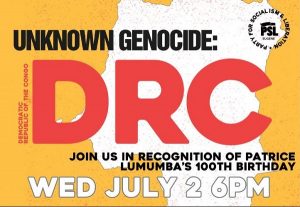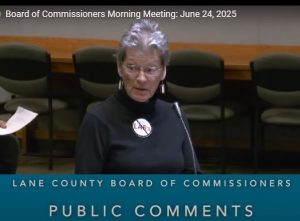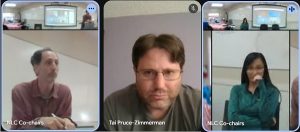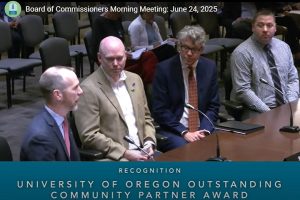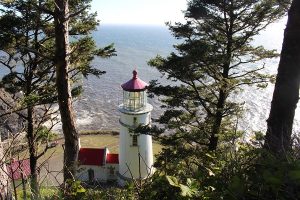Ready NW Eugene: After the earthquake, will we have a bridge to the hospital?
9 min read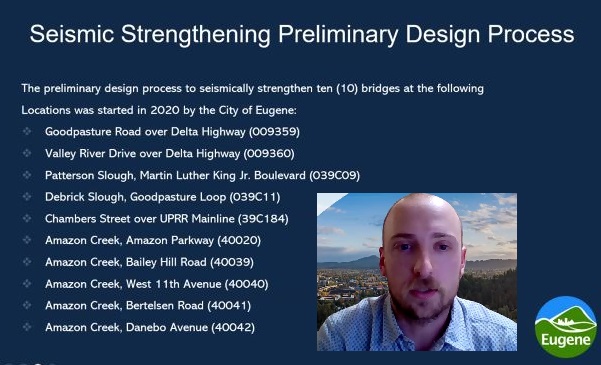
Will Eugene’s overpasses and bridges survive a big earthquake? Preparedness volunteers invited city staff to share information. For Ready NW Eugene on Jan. 30:
Charlsey Cartwright (Ready NW Eugene): In River Road, we’re pretty landlocked. If the bridges and overpasses were to fail, we would have no way out of our neighborhood to speak of. When we first thought about doing this meeting, one assumption was that our existing bridges and overpasses, as we understand it, are not seismically engineered. Transportation access will be critically important in a disaster.
[00:00:44] Joel Robe (Ready NW Eugene): Now that we’ve got the hospital on the other side of the river, we don’t have one in Eugene anymore. It’s pretty important that something happens to allow us to get across the river somewhere… If bridges were compromised, how would people on the west side of the river get to the hospital? And how would aid from the airport get to the east side of the river?
[00:01:03] Carlos Barrera (CERT lead, Southeast District): In a major earthquake, the sewer system and water supply lines will be disrupted probably, for a significant period of time. Without these systems it’s very likely that we would shortly be in the grips of a cholera pandemic. So as such, I think that it’s critical to pay attention to evacuation routes, ’cause in order to forestall a pandemic of cholera, it would be necessary to virtually evacuate the entire population of Springfield and Eugene.
[00:01:39] Charlsey Cartwright (Ready NW Eugene): And that’s why the title says the ‘Seismic Safety of the Bridges and Overpasses in the Northwest Region.’ We need to know the current status of those bridges and overpasses, which ones are going to be retrofitted, and is there a way in which the community’s voice can be taken into consideration in that process?
[00:02:05] We were so lucky to get really good speakers tonight. The first is going to be Trish Sharma.
[00:02:14] Trisha Sharma (Eugene Transportation Planning): I am Trisha Sharma and I’m a transportation planner with city of Eugene Transportation Planning team. We’re trying to take steps to enhance emergency preparedness.
[00:02:26] So in 2020, we identified 10 bridges and these were identified through a collaborative emergency preparedness effort with Lane County, ODOT (Oregon Department of Transportation), and I believe there was some involvement from the Lane Council of Governments as well:
- Goodpasture Road over Delta Highway
- Valley River Driver over Delta Highway
- Patterson Slough, Martin Luther King Jr. Boulevard
- Debrick Slough, Goodpasture Loop
- Chambers Street over Union Pacific Railroad Mainline
- Amazon Creek, Amazon Parkway
- Amazon Creek, Bailey Hill Road
- Amazon Creek, West 11th Avenue
- Amazon Creek, Bertlesen Road
- Amazon Creek, Danebo Avenue
[00:02:44] While none of these bridges have been seismically retrofitted as of today, the process is already in place.
[00:02:53] To talk about project proposals and the approval process, I also have Jordan Vesper, our civil engineer with the City of Eugene here, and I will let Jordan go ahead and talk about that.
[00:03:06] Jordan Vesper (Eugene Public Works Engineering): So it started with the analysis that we did in 2020 and the original process was 30 bridges and we had a evaluation criteria that included things like: the type of road that it was on; the classification of the road; the amount of traffic that goes over it; proximity to schools and emergency facilities; and basically ‘islands:’ So if there were populations that would be isolated based on a bridge, we also used that as one of our criteria.
[00:03:41] And so from there we worked towards this group of 10 bridges that we felt were the first round to get either seismically upgraded or replaced.
[00:03:53] So since we’ve started approaching or applying for funding in 2020 and have started receiving that, we have four projects that are getting close to being able to start construction. So we’re making really good progress and continuing to look at opportunities outside of just our normal funding sources to expand and accelerate construction of these bridges or getting them seismically upgraded.
[00:04:21] The Chambers overpass is going to start in the construction in probably March or April. And so that’ll be seismically upgraded. That’s the one going over the railroad tracks between Second and Roosevelt. And that project will last about nine months and then it’ll be seismically stable; in the occurrence that we get an earthquake of that magnitude, it will still be standing.
[00:04:46] When we’re working through these projects, we get about 90 cents on the dollar from the feds when we are able to be successful in the grant. And a lot of those have a match. And our bridge projects are anywhere from $4 million all the way up to, we have a couple that we’re looking at doing that are in the $16 to $20 million range. Even a 10% responsibility by the city is still a significant amount of money that we’re having to invest.
[00:05:13] So our goal is to do a bridge every couple years, and we’re still trying to determine where that funding is coming from locally, and how we continue to have sustained funding so that we can upgrade not only those 10, but then move into the next phase. What are the next ones that we’re going to evaluate and how are we going to upgrade these?
[00:05:33] It’s not a short process. It’s going to be years for us to get all of these bridges evaluated and determine the appropriate approach, whether it’s replacement or retrofit, and then securing funding and getting the construction actually completed.
[00:05:47] The bottleneck for us is funding. That’s the biggest thing. And so there’s a couple different programs that we get funding out of. The main one is a local bridge program through ODOT, but they limit how much each region and each agency get, which doesn’t allow us to progress faster.
[00:06:07] We would love to be able to do more projects, but we don’t have the funding.
[00:06:12] Trisha Sharma (Eugene Transportation Planning): There’s a fine line between competitive funding and non-competitive funding. Just the pool, like the overall pool of non-competitive funding is so low, that every time we apply for federal grants, unfortunately there are larger cities with more pressing needs—at least that’s how it’s perceived by the federal government. And so we’re competing, I would say, with five, 600 different competitors across the whole nation. So…
[00:06:42] Jordan Vesper (Eugene Public Works Engineering): And a lot of the funding applications that we go after, we don’t meet the minimum threshold for funding. So they want bridges that are in the $50, $100, $500 million range, and our biggest projects are in the $20 million. So a lot of those, we’re not able to even apply for.
[00:07:00] Fred Miller (Ready NW Eugene): I have a suggestion: Maybe the Oregon Rainy Day Kicker fund could be accessed for these kind of projects. We might have to write legislators to ask about that.
[00:07:15] Joel Robe (Ready NW Eugene): How do you determine if the infrastructure is seismically stable?
[00:07:20] Jordan Vesper (Eugene Public Works Engineering): Yeah, so we take the as-construct drawings, which have all the components of the bridge, all the rebar that’s running through it, and build a 3-D model out of that. And from there we can apply different forces to it, which would mimic an earthquake and determine if it’s going to fail or not. From that evaluation, we can then start to figure out what the fix is, how do we make it seismically stable?
[00:07:51] Joel Robe (Ready NW Eugene): Has there been any studies to determine what shape our roads will be in after a Cascadia earthquake?
[00:08:00] Jordan Vesper (Eugene Public Works Engineering): We have not, no. There’s a lot of factors that go into that. It’s not just the road prism, like the, what you drive on. It’s not just the asphalt, it’s everything that’s underneath it. So we have pipes under our roads that are over 100 years old. And if those fail, then we’re going to have a void where that road’s going to come down. But if the pipes hold, then there should be localized cracking in the asphalt. But I wouldn’t anticipate that we’re going to have large scale, roads breaking apart or falling apart.
[00:08:30] Now when you get into deeper sections, or like the South Hills or areas that are built on clays, you may see more of that cracking from just the soils expanding. And that’s going to be the biggest issue for us is the contraction of the soils.
[00:08:46] Charlsey Cartwright (Ready NW Eugene): There’s been a number of questions about the pedestrian and bicycle bridges going over the Willamette. Are they seismically retrofitted or are there plans to do that?
[00:08:59] Jordan Vesper (Eugene Public Works Engineering): So pedestrian and bicycle bridges are not going to be priority at this point, no. The vehicular bridges being able to maintain emergency services and get people in and out of town is going to be the highest priority. And then we’ll start to evaluate if there’s opportunities to do pedestrian bridges.
[00:09:19] There are some that can carry the load of emergency vehicles and so those ones will be the highest priority as opposed to like a five-foot-wide bridge that only pedestrians go across. ‘Cause that’s not going to provide as much function overall to the network, as opposed to something that can carry a vehicle.
[00:09:38] Duncan Rhodes (Jefferson Westside): It looks to me like we’re not paying too much attention to the non-vehicular modes of travel, and assuming our roads are smoked after a Cascadia subduction event, we’re going to be relying a lot more on foot traffic and bicycle traffic…Well, I think we ought to leave some room for other modes of transportation to be in a supporting role, ’cause cars may not be able to get down the road, but a bike probably would.
[00:10:06] Joel Robe (Ready NW Eugene): There’s a question about: ’30th Avenue is a lifeline for South Eugene.’ There’s another: Is the overpass at highway, or Interstate 5, I guess, secure?
[00:10:19] Jordan Vesper (Eugene Public Works Engineering): I could talk a little bit about the 30th Avenue Bridge. We had an evaluation on that bridge done last year, and it’s not seismically stable. We’ll continue to evaluate if that is one that we’re going to retrofit or replace. But it would be after the list of 10 that we’re currently working through.
[00:10:39] Thia Bell (Ready Eugene): Has there been any thought or planning to the cumulative impacts of an earthquake and as far as living downstream in a timbered area where a lot of trees and other debris and mudflow could come down through the rivers and jam up against the bridges?
[00:10:57] So we’re not looking at just seismic stability for the initial shaking, but the long-term impact of what could be a lot of a lot of stuff happening there. I know that’s probably in nobody’s jurisdiction, but I’m curious if it’s in the hazard plan or… and also that could reroute the river in the River Road area / Santa Clara area. So, that’s a concern about logjams and their impact on the bridges and roads around us.
[00:11:27] Jordan Vesper (Eugene Public Works Engineering): With respect to logjams and that sort of stuff, building up around bridges, more than likely it’s going to be an evaluation after the fact. We can build abutments and retaining walls around the bridges, but the magnitude of this is, it’s going to be something that’s going to make more sense after the fact to be able to try and mitigate.
[00:11:46] I actually have a meeting later this week about debris cleanup… We’ll get back to you with answering a lot of these questions.
[00:12:05] John Q: With the hospital now on the other side of the river, Ready NW Eugene invites city staff to discuss seismic safety of overpasses and bridges. To get involved with your preparedness committee, contact your neighborhood association.
